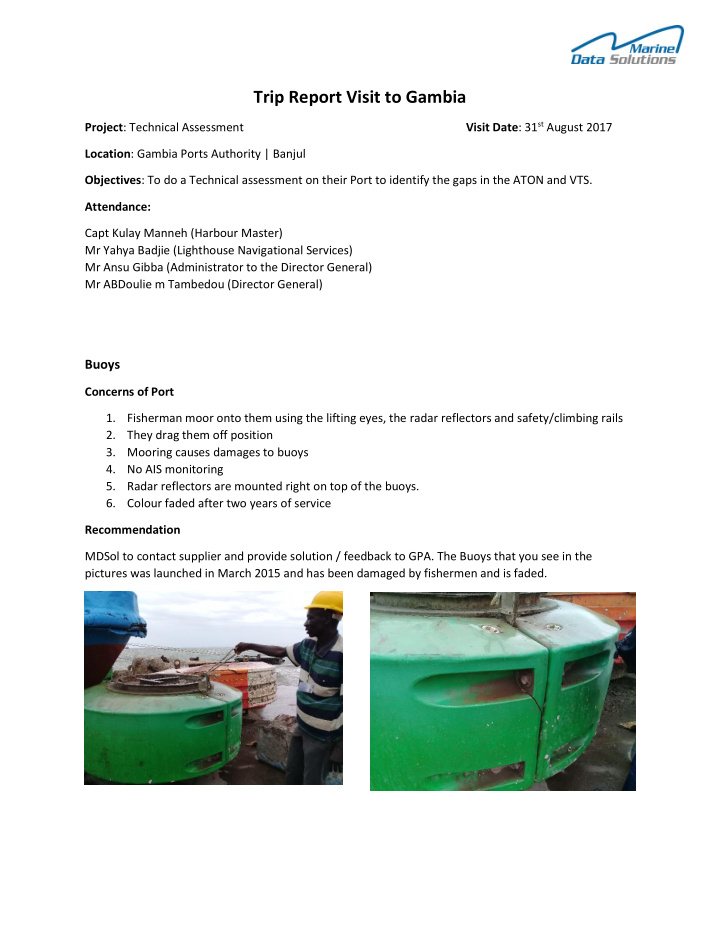



Trip Report Visit to Gambia Visit Date : 31 st August 2017 Project : Technical Assessment Location : Gambia Ports Authority | Banjul Objectives : To do a Technical assessment on their Port to identify the gaps in the ATON and VTS. Attendance: Capt Kulay Manneh (Harbour Master) Mr Yahya Badjie (Lighthouse Navigational Services) Mr Ansu Gibba (Administrator to the Director General) Mr ABDoulie m Tambedou (Director General) Buoys Concerns of Port 1. Fisherman moor onto them using the lifting eyes, the radar reflectors and safety/climbing rails 2. They drag them off position 3. Mooring causes damages to buoys 4. No AIS monitoring 5. Radar reflectors are mounted right on top of the buoys. 6. Colour faded after two years of service Recommendation MDSol to contact supplier and provide solution / feedback to GPA. The Buoys that you see in the pictures was launched in March 2015 and has been damaged by fishermen and is faded.
1Fairway Buoy
Buoy Lights 1. Not fitted with GPS to synchronize the flashes 2. Lights need to be removed to re-program or do status checks Recommendation 1. Use lights with GPS and AIS functionality. 2. AIS will send messages and warnings to the VTS system when buoys are dragged or moved from position. 3. New lights have Bluetooth technology for remote programming and maintenance a. Enhances staff safety – no need to climb onto buoy b. More effective maintenance and scheduling of component replacements before failure
Lighthouse Lights 1. No buildings but towers are used 2. Lights used are flashing and not rotating and are sealed outdoor units 3. Pharos supplied units 4. They have 3 of these units mounted on towers - Banjul Tower – 12nm (WHITE) - Fajara Lighthouse – 15nm (WHITE) - Barra Tower Light – 10nm (RED) 5. Daylight sensor went faulty and they had to replace complete light. (No Spares) 6. Light houses(towers) are solar powered Recommendations: MDSol will approach Sealite for a new light source. Leading markers (No Lights) 1. Physical markers are used and not lights 2. Port requires lights 3. Light information and specs to be provided by GPA
VTS system Concerns of the Port 1. Fishermen drag buoys off position. No VTS monitoring of Buoys 2. No AIS and Radar currently installed at the Port. Current Installed Systems • VHF Radio • Navtex • SSB and MRSAT C- Installation is incomplete Benefits of AIS and RADAR to the customer • Will have Radar visibility of buoys to ensure they do not drift off position. • Buoys that sunk will be detected by the 2 Port Control operator on duty on the VTS display (Radar). • Buoys with AIS capability will be displayed on the VTS system for the operator to monitor. • Activity of fishing vessels around the buoys can be monitored and limited by the VTS operator. • Added security and reduction in maintenance cost to the port assets and equipment. • Promote safety • Improves efficiency of Vessel Traffic within the port. • Protect the environment • Improves Coordination of Search and Rescue • Assessment of risk Requirement Radar coverage requirement • +-7 NM From the port tower up and down the channel • +- 12 NM from Fajara site 3 Port Control
Port Control Centre • 1 VTS Display System • AIS (installed in Control centre to reduce cable run) • AIS antennas (to be mounted on Port Control roof) Server Room (Control Centre) • Server room is on ground floor and has UPS, Aircon, sufficient space for another cabinet and cable access to the control centre. • VHF Reciters (required) Figure 4 Server Room • VTS Recorder (required) Port Control Radar Tower (First RADAR Site) • Radar to be mounted on the Tower in front of the current port control building • This tower needs to be replaced with a higher unit to accommodate the car carriers entering the port (45m high – as per captain Manneh) • Tower Height recommended is 60meters • Connectivity between the Tower and Port Control to be established • Kiosk at Tower with aircon and UPS (for CSET depending on Radar used) • Current Port authority building has a standby generator to overcome electricity issues in the Town. Fajara Lighthouse Tower (Second RADAR Site) 5 . Radar Tower (First Site)
6 . Radar Tower (Second Site) • This site is +- 15 meters above sea level and the Tower is an additional 15 Meters • A new tower structure is recommended to accommodate the Radar installation and a height of at least 60 meters above sea level is required. (12nm Coverage Required) • Microwave link from this site to the new structure in the port. (depending on line of site) o Line of site to be confirmed by Yanya Badjie – Lighthouse technician • This site currently has 1 solar panel for the light only. • Electricity is not stable at this site. Can be off for 4 -5 hours in a day. • Recommend a Kiosk at Tower with aircon and UPS (for CSET depending on Radar used) • Generator also required at this site due to Power outages Customer System Delivery Plan (Phased Approach) 1. VTS with AIS monitoring capability 2. Optional on 1st approach, AIS and VHF recording (including VTS Recorder, and four VHF Receiver Units). 3. Port Control Radar 4. Fajara Radar 5. SLA for maintenance separate
Additional Pictures (Larger Format) 7 GPA Building 8 Port Control
9 Server Room 10 GPA Building Entrance
12 Server Room 11 Server Room
Recommend
More recommend